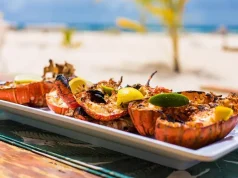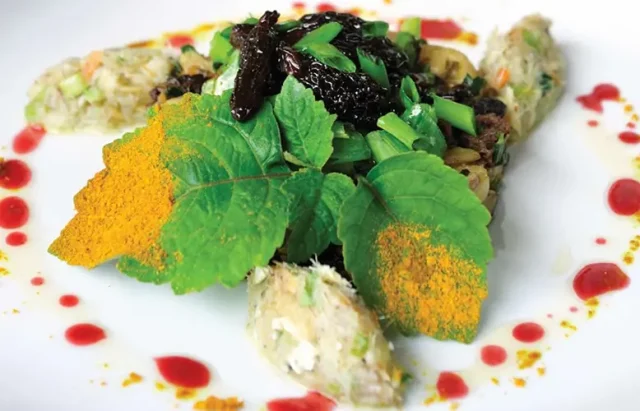
Once upon a shimmering sea, there lay an emerald jewel known as Martinique, a magical island where legends were woven into the very fabric of its lush, UNESCO-recognized landscapes. In the air, the scent of the island’s countless wildflowers marks its friendly inhabitants with an undeniably fragrant aroma. Take another sniff, however, and you just might detect another layer to the island’s complex bouquet – one that reflects the hearty spices and fresh, local ingredients prized by the chefs of Martinique.
The incredible gastronomy of Martinique is a product of centuries of cultural blending, but there’s nothing outdated about the taste. Every mouthful of exquisite Creole cuisine on the island says something about its cultures, eras and tastes; this unique culinary legacy weaves a tale of French-Caribbean harmony that leaves an indelible mark on your heart and taste buds. Among the many (many) reasons to visit Martinique, this novel cuisine may just be the foremost. If we’ve got your interest piqued and your mouth watering, read on for a more in-depth look at exactly why this Caribbean island deserves a spot on every foodie’s bucket list.
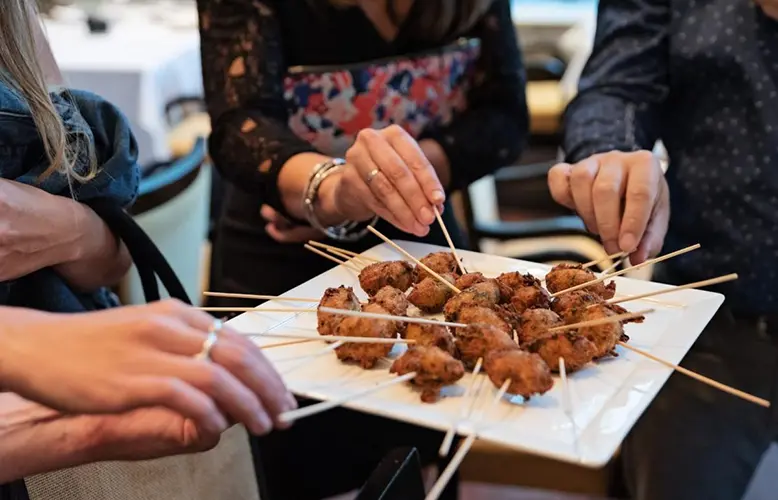
A Truly Global Cuisine
Modern Martinique’s cuisine is the picture of culinary diversity, drawing its strength from cuisines from all over the world to create a new one that “Creolized” Caribbean society.
The first notes of this tasty symphony were played by the Arawak people, who planted seeds of corn, cassava, and sweet potatoes. Then came the winds of change, carrying the heartache of the African slaves, who brought with them the rhythm of their ancestors, staples like rice and accras, and the soulful spice of their homeland.
The arrival of French settlers brought the finesse of European techniques, while waves of immigrants from India and other Caribbean islands added their own unique ingredients to the mix, as well as modern taste preferences for mango and coconut-based desserts. The fusion of these influences created the Creole culture, where the fiery charm of African spices married with the elegance of French sauces, all seasoned with the abundance of local produce. The Indians and Hindus added their aromatic herbs and curry blends, and the Chinese sprinkled their culinary magic, leaving behind the art of stir-frying and dim sum delights. Each chapter of this culinary story was written with love and hardship, weaving tales of celebration and sorrow into every pot of gumbo and callaloo. Today, the rich tapestry of Martinique cuisine stands as a testament to the resilience of its people, a nourishing legacy that embraces diversity and celebrates the flavours of history in every mouthful.
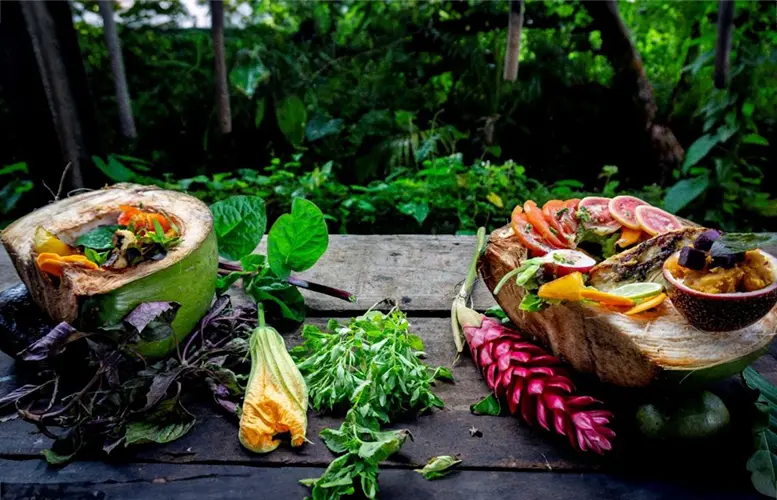
French Flavours
As you might expect from a distinctly French island, Martinique’s take on Creole-fusion is fundamentally informed by the culinary practices of France. These techniques and traditions were imported to Martinique during its colonial era in the 1600s, and have only taken deeper root since then. French cuisine in general has grown to be counted among the best in the world, so much so as to be known as one of UNESCO’s intangible cultural treasures. The uniquely verdant environment of volcanic Martinique allowed the island’s chefs to realize French staples with the finest local ingredients, like freshly caught seafood and organic tropical fruit. It is this novel element that arguably defines the modern Martinique take on French cuisine as one that honours its savoury origins with more organic, citrusy tastes.
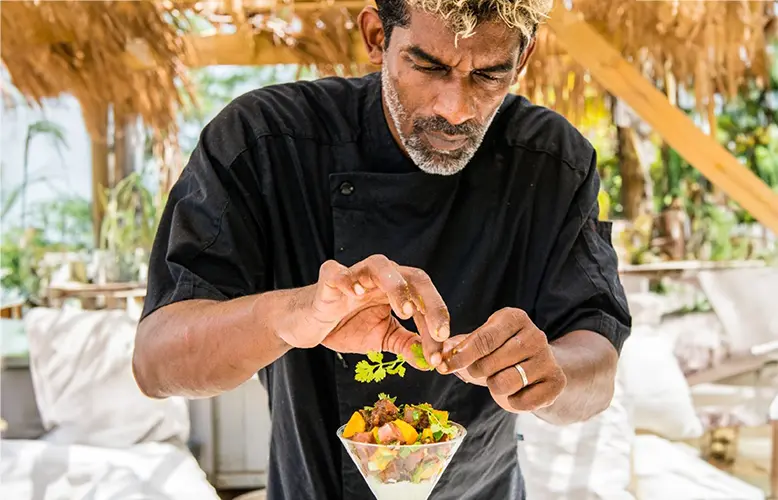
As the scents of buttery croissants and coq au vin flit through the air over the streets of Fort-de-France, they find an enchanting partner in Creole cuisine’s signature earthy spices and vibrant colours. It’s a culinary pas de deux that echoes through generations, where bouillabaisse (Provençal fish soup) meets callaloo (a side dish made primarily of leafy greens in Caribbean culture), and escargot (edible land snails) finds a new home alongside saltfish accras. With its precision of structure and finesse, the art of French cooking whispers sweet nothings to the rhythm of Martinican gastronomy to realize an entirely new cuisine that is bold in both appearance and flavour profile. Yet, Martinique’s cuisine has many more stories to tell. While France can claim a starring role, this gastronomic tale has many critical supporting actors who deserve their own time in the spotlight.
Influences from Abroad
Modern Martinique’s cuisine is the picture of culinary diversity, drawing its strength from cuisines from all over the world to create a new one that “Creolized” Caribbean society.
The first notes of this tasty symphony were played by the Arawak people, who planted seeds of corn, cassava, and sweet potatoes. Then came the winds of change, carrying the heartache of the African slaves, who brought with them the rhythm of their ancestors and the soulful spice of their cuisine. The arrival of French settlers brought the finesse of European techniques, while waves of immigrants from India and other Caribbean islands added their own unique ingredients to the mix. The fusion of these influences created the Creole culture, where the fiery charm of African spices married with the elegance of French sauces, all seasoned with the abundance of local produce. The Indians and Hindus added their aromatic herbs and curry blends, and the Chinese sprinkled their culinary magic, leaving behind the art of stir-frying and dim sum delights. Each chapter of this culinary story was written with love and hardship, weaving tales of celebration and sorrow into every pot of gumbo and callaloo. Today, the rich tapestry of Martinique cuisine stands as a testament to the resilience of its people, a nourishing legacy that embraces diversity and celebrates the flavours of history in every mouthful.
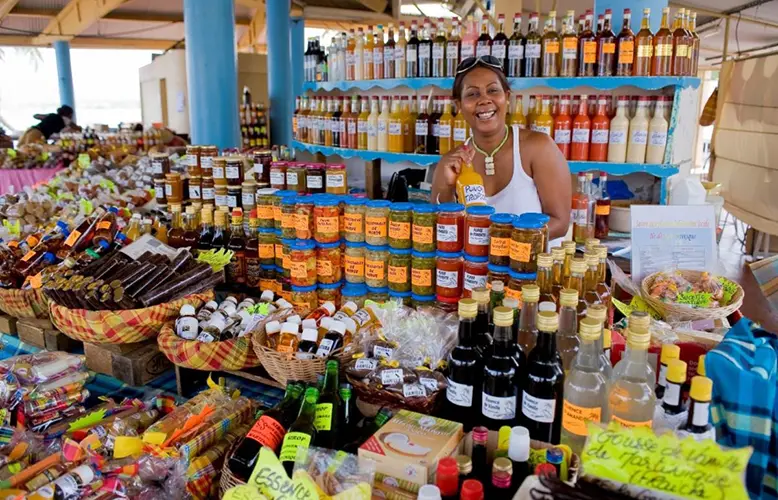
History You Can Taste: The Dishes in Martinique
If you’ve made it this far while contending with a growling stomach, you deserve to be commended. Rest assured, we won’t conclude without diving into exactly the sort of fare you’ll want to try while visiting Martinique. Dining in Martinique is an invitation to embrace the island’s soul, whether at a charming hotel, a seaside eatery, or the humble front porch of a skilled local cook. But for a taste of true Créole authenticity, seek out the unpretentious “down-home” establishments, where generations have passed down their cherished recipes and hospitality flows like a warm, familiar embrace. Here are the top names of Creole Cuisine that show your acknowledgement of the island’s culinary masterpieces when you visit vendors:
- Accras de Morue (cod fritters)
- Lambis (conch/large sea snail)
- Chatrou (small octopus)
- Poulet boucané (Martinican barbecued chicken)
- Ouassou (freshwater crayfish)
- Langouste Grillée (grilled lobster)
- Crabes Farcis (stuffed crab)
- Boudin Créole (blood sausage)
- Colombo dishes
- Curry Terrine
- Féroce d’Avocat (appetizer-fierce avocado)
- Blanc Manger Coco (sweet dessert)
- Rhum Agricole Ti-Punch
In Martinique, where hills of green punctuate a sea of endless blue, the artful elegance of French cooking pairs with the fiery spirit of African spices and the exotic allure of South Asian ingredients. These Creole recipes stand on their own merits as harmonious fusions that elevate Martinique above other tropical paradises



